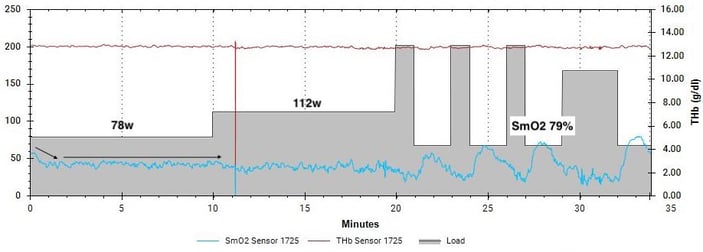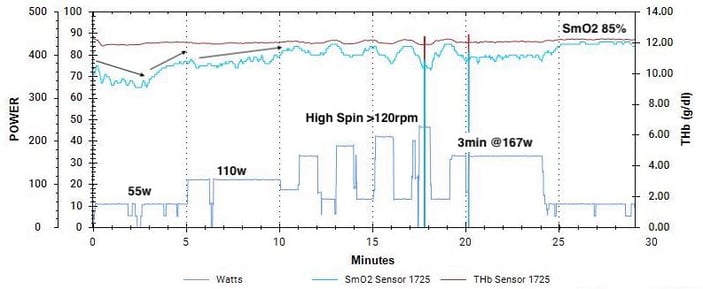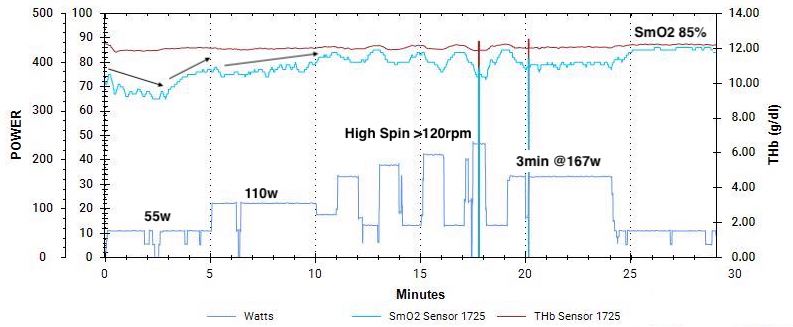How to use Moxy to Monitor Warm-up Status
In Part 1: Creating a Proper Warm-up the principles of a proper warm-up were discussed as well as a simple FTP based warm-up model which allows for the creation of a simple, effective warm-up. A warm-up should leave an athlete feeling invigorated, and prepared both mentally and physically for the hard work ahead, whether that be a race or tough workout.
Before creating a personalized cycling warm-up it’s recommended that an athlete know their FTP/CP, from this, a good starting point for a warm-up is as follows:
Athletes' FTP: 223w
10 minutes @ 20% FTP – 45w
10 minutes @ 40% FTP – 90w
3x45s High RPM Spins @ 75% FTP – 167w with 1.5 minutes rest the first minute of rest should be completely stationary (more on this below)
3minutes @ 80-90% FTP – 178-200w, this portion should be treated as just under race effort, pause for 1 minute after completion.
Now that we have a template for a warm-up, we can begin to perfect this warm-up by using Moxy. Moxy allows an athlete or coach to monitor, in real-time, oxygen saturation, SmO2 (how much oxygen is being used) and total hemoglobin, THb (how much blood is being delivered) at the level of the working muscle, in most cases the vastus lateralis.
Using the Moxy might seem daunting at first but as far as a warm-up is concerned the goal is to push both SmO2 (typically >80%) and THb as high as possible without causing undue fatigue. In order to accomplish this its recommended that an athlete practice and revise their warm-up well before race day. It's important to play around with different times and intensities of each of the different portions of the warm-up, the idea of using Moxy as a means for a warm-up is to design a completely customized warm-up suited to the needs of each athlete.
In the following example I will show you how I used Moxy to tweak and tailor my warm-up as well as some mistakes I made along the way, in hopes that you don’t make these mistakes as well.
To start, remember that the beginning of a warm-up needs to be easy enough to allow the body to increase cardiac output, vasodilate arterioles, and saturate the working muscle with oxygen. Typically, SmO2 values start around 45-60%, but this is variable depending on the placement of the Moxy just remember that the goal of the warm-up should be to push that SmO2 as high as possible.
Figure 1 shows the SmO2 response of a warm-up that is too challenging. The warm-up started at too high of an intensity, which is shown by a steep drop in oxygenation that never recovers, indicating that non-aerobic pathways are being used and oxygen tension is being maintained through oxy-myoglobin stores. While SmO2 can still be pushed fairly high after the spin up and steady state high FTP portions the SmO2 doesn’t stay as high as the second warm-up.

Figure 2 shows a proper warm-up. Notice the slight drop in SmO2 with a subsequent rise which indicates that the resistance is low enough for oxygen homeostasis to be maintained, and delivery to be increased. The SmO2 signal continues to rise after the high spin portions of the warm-up and remains elevated at ~85% during the rest before the workout.

To sum up:
The steady state portions of the warm-up need to be easy enough to provide a continuous increase in SmO2, they need to be long enough to push SmO2 as high as possible, and there should not be a steep decrease in SmO2 when starting the warm-up.
The high spin portions and 75% FTP should lower SmO2 with a subsequent increase in SmO2 after rest. For example, if SmO2 started at 65% before, do not start the next stage until after SmO2 reaches >65%. Continue to repeat which ever works best until SmO2 is maxed out.
Finally, practice your tailored warm-up, the more you practice the easier it will be to warm-up come race day.

